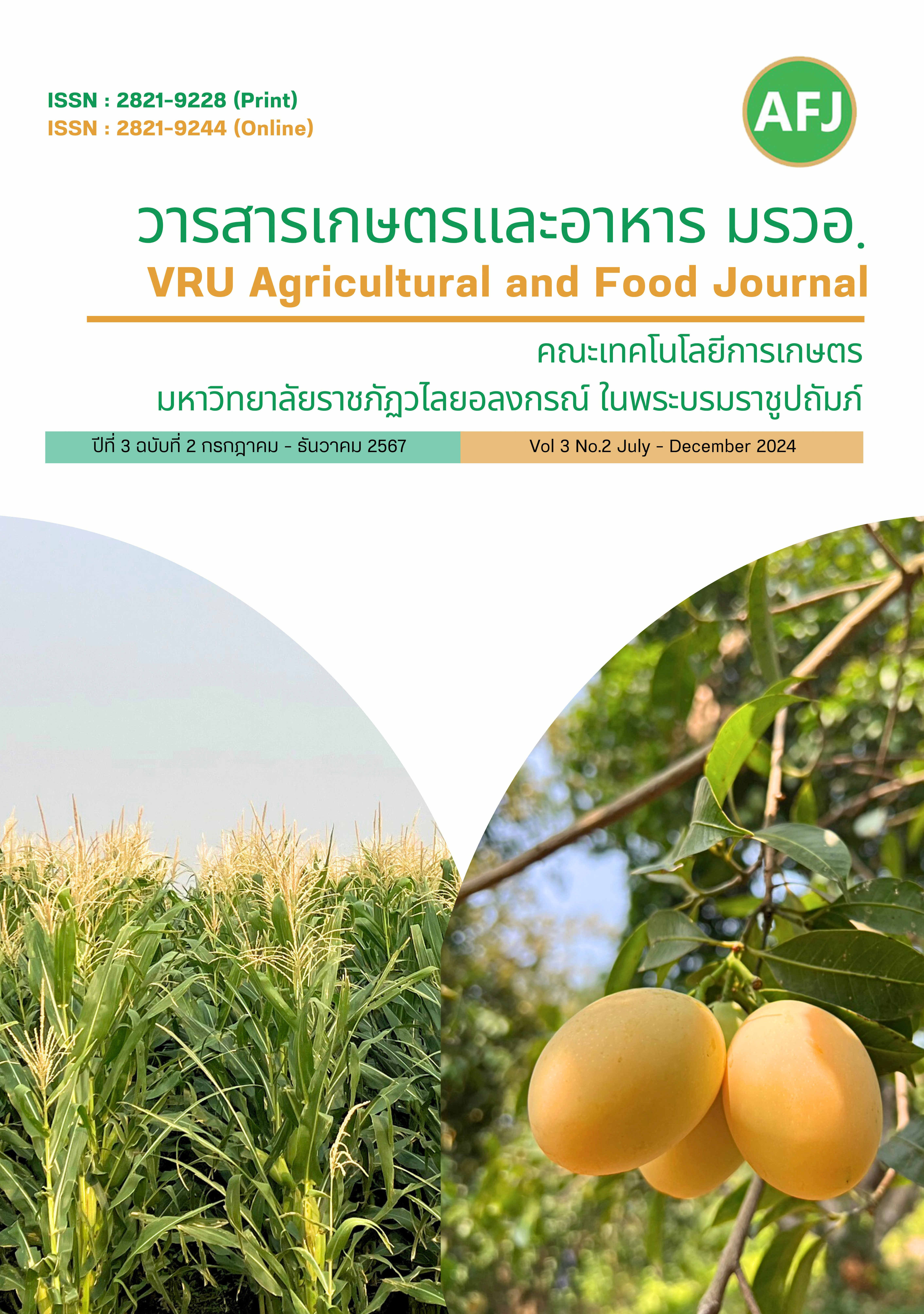ผลของพันธุ์มันสำปะหลังสายพันธุ์ก้าวหน้าต่อผลผลิต คุณภาพด้านเนื้อสัมผัส และการยอมรับของผู้บริโภคต่อผลิตภัณฑ์แปรรูป
Main Article Content
บทคัดย่อ
มันสำปะหลังเป็นพืชที่อุดมไปด้วยคาร์โบไฮเดรต เส้นใย วิตามิน และแร่ธาตุต่างๆ มันสำปะหลังพันธุ์ห้านาที และระยอง 2 เป็นมันสำปะหลังชนิดหวานที่นิยมนำหัวสดมาบริโภคโดยตรง แต่มันสำปะหลังทั้ง 2 พันธุ์ มีข้อด้อย คือ ให้ผลผลิตต่ำ และมีอัตราการงอกต่ำ ตามลำดับ จึงทำการศึกษาผลของสายพันธุ์/พันธุ์มันสำปะหลัง จำนวน 6 สายพันธุ์/พันธุ์ ได้แก่ (1) CMRE60-03-02 (2) CMRE60-03-13 (3) OMRE60-01-02 (4) OMRE60-02-12 (5) ห้านาที และ(6) ระยอง 2 ต่อผลผลิต เนื้อสัมผัส และรสชาติเมื่อนำมาแปรรูปเป็นมันสำปะหลังนึ่งและมันสำปะหลังแผ่นทอดกรอบ วางแผนการทดลองแบบสุ่ม ในบล็อกสมบูรณ์ จำนวน 4 ซ้ำ พบว่า สายพันธุ์ CMRE60-03-02 CMRE60-03-13 และ OMRE60-01-02 ให้ผลผลิตหัวสดสูงกว่าพันธุ์ห้านาที ร้อยละ 35 4 และ 1 ตามลำดับ และทั้ง 3 สายพันธุ์ ยังให้ผลผลิตหัวสดสูงกว่า พันธุ์ระยอง 2 ร้อยละ 39 6 และ 4 ตามลำดับ เมื่อเปรียบเทียบคุณภาพด้านเนื้อสัมผัส พบว่า มันนึ่งจากสายพันธุ์ CMRE60-03-13 และ OMRE60-02-12 มีคุณภาพด้านเนื้อสัมผัสใกล้เคียงพันธุ์ห้านาที ส่วนมันแผ่นทอดกรอบจากสายพันธุ์ OMRE60-02-12 และ CMRE60-03-13 มีคุณภาพด้านเนื้อสัมผัสใกล้เคียงกับระยอง 2 ส่วนคุณภาพทางประสาทสัมผัส พบว่า มันนึ่งจากสายพันธุ์ OMRE60-02-12 ได้รับคะแนนการยอมรับทางประสาทสัมผัสทุกด้านสูงกว่าพันธุ์ห้านาที และสายพันธุ์ OMRE60-02-12 ได้รับคะแนนการยอมรับทางประสาทสัมผัสทุกด้านใกล้เคียงระยอง 2 ดังนั้น สายพันธุ์ OMRE60-02-12 เหมาะสำหรับการปลูกในสภาพไร่ จังหวัดระยอง เนื่องจากให้ผลผลิตหัวสด ไม่แตกต่างจากพันธุ์อื่น มีปริมาณไซยาไนด์ต่ำ เมื่อนำไปแปรรูปเป็นมันนึ่งและ มันแผ่นทอดกรอบ มีรสชาติและคุณภาพทางกายภาพที่ดี
Article Details

อนุญาตภายใต้เงื่อนไข Creative Commons Attribution-NonCommercial-NoDerivatives 4.0 International License.
บทความนี้ได้รับการเผยแพร่ภายใต้สัญญาอนุญาต Creative Commons Attribution-NonCommercial-NoDerivatives 4.0 International (CC BY-NC-ND 4.0) ซึ่งอนุญาตให้ผู้อื่นสามารถแชร์บทความได้โดยให้เครดิตผู้เขียนและห้ามนำไปใช้เพื่อการค้าหรือดัดแปลง หากต้องการใช้งานซ้ำในลักษณะอื่น ๆ หรือการเผยแพร่ซ้ำ จำเป็นต้องได้รับอนุญาตจากวารสารเอกสารอ้างอิง
Agronomy Research Institute and Renewable Energy Plants. 2015. Cassava Data Recording Manual. Department of Agriculture. (in Thai)
Amawan, S. 2021. Research Project Report: Research and Development on Cassava Variety Improvement for Increasing Production Efficiency. Department of Agriculture. (in Thai)
Boonseng, O. 2020. Thai Cassava Biology, Production and Utilization. (in Thai)
Cassava and Product Research Center Technopolis Suranaree University of Technology. n.d. Varieties of cassava. Available Source: http://web.sut.ac.th/cassava/?name=1cas_source/cas_source/. January 16 2019. (in Thai)
Chaisri, S., P. Chaisri, E. Sarobol, K. Panitnok, S. Ngamprasitthi and P. Changlek. 2012. Yield Stability of Recommended KU Cassava Varieties Grown in Upper North Region of Thailand. In The 50th Kasetsart University Annual Conference, Bangkok. 318-324 (in Thai)
Hansethasuk, J. 2009. Properties and benefits of cassava roots and starch. Rayong Field Crops Research Center, Department of Agriculture. (in Thai)
Kasetsart University. 2021. Harvesting cassava. Available Source: https://icassava.eng.ku.ac.th/wiki/index.php?title= Harvesting cassava & mobileaction=toggle_view_desktop, October 31, 2023. (in Thai)
Kasetsart University Research and Development Institute. 2015. Cassava: Characterization of cassava types and varieties. Available Source: https://www3.rdi.ku.ac.th/?p=18052. September 24, 2023. (in Thai)
Mulualem, T. and B. Ayenew. 2012. Cassava (Mannihot esculenta Cranz) Varieties and Harvesting Stages Influenced Yield and Yield Related Components. Journal of Natural Sciences Research. 2: 122-129.
Nual-on, S. 2007. Physiology, production and postharvest of cassava. Kalasin Field Crops Research Center, Department of Agriculture. (in Thai)
Petchalanuwat, C., K. Srirath, V. Vichukit, C. Rojanaridpiched, V. Pornprompratan and W. Wattananon. 1996. Effect of Varieties and Harvesting Dates on Yield, Paste Viscosity and Gelatinisation Properties of Cassava Starch. Thai Agricultural research journal 14: 11-17. (in Thai)
Rayong Field Crops Research Center. 1994. Cassava. Field Crops Research Institute, Department of Agriculture, Ministry of Agriculture and Cooperative. Bangkok. (in Thai)
Rodpeawpan, K., C. Inplean, S. Sansanee and T. Kumchoo. 2024. Comparison of Cassava Lines/Varieties and Proper Harvesting Period for Processing to French Fries. Thai Agricultural research journal 42: 131-144. (in Thai)
Rojanaridpiched, C., P. Pulsanguan, S. Phuddachareon, J. Jeamjamnanja, and W. Saengkaewsook. 1987. Study on Planting Season of Cassava. KASETSART JOURNAL: NATURAL SCIENCE 21: 199-125. (in Thai)
Padmaja, G. 1995. Cyanide detoxification in cassava for food and feed used. In Critical Review in food science and nutrition 35: 299-339.
Williams, H.J. and T.G. Edwards. 1980. Estimation of cyanide with alkaline picrate. Journal of the Science of Food and Agriculture 31: 15-22.

